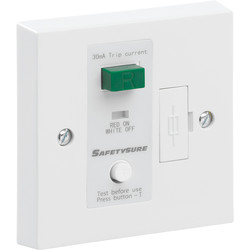Hi,
I am planning to install an outdoor socket as a spur from an existing socket on a 16A radial circuit.
When initially looking at the work, I realised that the circuit is not RCD protected.
Because I wanted to keep the internal socket, I decided that I would buy a FCU with RCD, put that upstream of the internal socket and then have the outdoor RCD socket after that (please see the picture at the bottom). I thought that would be good because it would RCD protect the internal socket, and also RCD protect the cable run from the internal socket to the outdoor socket. This is the one I purchased.

 www.toolstation.com
www.toolstation.com
I have now realised that you are not supposed to put a Type A RCD downstream of a Type AC and, as far as I can tell, the outdoor socket is Type A.
I've struggled to confirm that the outdoor socket is Type A, but I did find this listing for it

which states "A.C and pulsating - D.C fault current sensitive" and I think that suggests that it is Type A.
Because of this, I think that I can do one of two things.
Alternative 1 - Branch the outdoor socket off upstream of the FCU, so that its Type AC is not upstream of the Type A socket.
Alternative 2 - Get rid of the internal socket, forget the FCU and just go CU -> Outdoor Socket
Alternative 3 - The same as Alternative 1, but losing the FCU and just using an RCD protected internal socket
Both of these alternatives would have to forego RCD protection on the cable to the outdoor socket.
I would prefer to keep the internal socket, and so would favour Alternative 1, or 3.
Any advice on this situation and specifically whether Alternative 1 is OK, would be much appreciated.
Also, could anybody please advise if an RCD socket also provides RCD protection for downstream sockets?
In the circuit CU -> RCD Socket -> Non-RCD Socket, is the Non-RCD socket protected by the RCD on the upstream socket?
If so, would the following fall foul of the same mixing RCD type problem
CU -> Type AC RCD Socket -> Type A RCD Socket (by putting Type AC protection upstream of Type A)?

I am planning to install an outdoor socket as a spur from an existing socket on a 16A radial circuit.
When initially looking at the work, I realised that the circuit is not RCD protected.
Because I wanted to keep the internal socket, I decided that I would buy a FCU with RCD, put that upstream of the internal socket and then have the outdoor RCD socket after that (please see the picture at the bottom). I thought that would be good because it would RCD protect the internal socket, and also RCD protect the cable run from the internal socket to the outdoor socket. This is the one I purchased.

SafetySure RCD Spur White
• Passive (does not need resetting after a power loss)• Conforms to BS7288:1990, BS1363
I have now realised that you are not supposed to put a Type A RCD downstream of a Type AC and, as far as I can tell, the outdoor socket is Type A.
I've struggled to confirm that the outdoor socket is Type A, but I did find this listing for it

2 Gang 13A Double Pole Switched Weatherproof Residual Current Device Sentry Socket Outlet (Passive) IP66 Grey
Part of Masterseal Plus range
www.cef.co.uk
which states "A.C and pulsating - D.C fault current sensitive" and I think that suggests that it is Type A.
Because of this, I think that I can do one of two things.
Alternative 1 - Branch the outdoor socket off upstream of the FCU, so that its Type AC is not upstream of the Type A socket.
Alternative 2 - Get rid of the internal socket, forget the FCU and just go CU -> Outdoor Socket
Alternative 3 - The same as Alternative 1, but losing the FCU and just using an RCD protected internal socket
Both of these alternatives would have to forego RCD protection on the cable to the outdoor socket.
I would prefer to keep the internal socket, and so would favour Alternative 1, or 3.
Any advice on this situation and specifically whether Alternative 1 is OK, would be much appreciated.
Also, could anybody please advise if an RCD socket also provides RCD protection for downstream sockets?
In the circuit CU -> RCD Socket -> Non-RCD Socket, is the Non-RCD socket protected by the RCD on the upstream socket?
If so, would the following fall foul of the same mixing RCD type problem
CU -> Type AC RCD Socket -> Type A RCD Socket (by putting Type AC protection upstream of Type A)?



